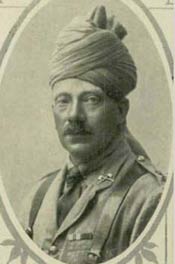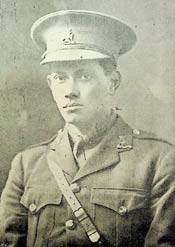The forgotten soldiers and a snapshot of Ceylonese community
The neglected and almost forgotten Kanatte memorial to the Ceylonese fallen of World War 1 (the Sunday Times, August 17, 2025) is interesting for many reasons. For one, it provides a succinct and fascinating snapshot as to how the Ceylonese community viewed themselves at that time.
The government of the era was, of course, colonial. Once the Great War (as it was known then) was over, it seemed intent on honouring the sacrifices made by all those who had connections to Ceylon. The famous architect Edward Lutyens was commissioned to build a ‘Victory Monument’ (ST, May 28, 2023), to be situated on Galle Face Green, that was slated to be the permanent memorial to the ‘War to end all wars’.

Major Ronald Edward Elliot Kriekenbeek
But a small group of prominent Ceylonese, headed by a journalist at the Ceylon Independent newspaper named Sperling Wootler, were of a different mindset. Wootler had already written a book entitled Young Ceylon on War Service, which had seen three editions, and was intimately familiar with the subject. This group, seemingly decided to honour those they regarded as Ceylonese, with deep roots in Ceylon, separately from the many British transplants who also made the supreme sacrifice.
This writer must acknowledge the curators of the National Museum in Colombo who have preserved two editions of Wootler’s book; and Pasan Gunaratne, who unearthed these priceless volumes and had them copied for me. Without Pasan’s resourcefulness we would know very little about this chapter of our history.
Ceylonese
Mr. Wootler himself was part of the ‘Burgher’ community. This was defined by the Chief Justice of Ceylon, Sir Richard Ottley, in 1883 as ‘a person whose paternal ancestor was European’. Sperling Tweedale Wootler (what a splendid name!) was born in 1884 and was the son of Charles Nixon Wootler, an Englishman, and Laura Edith de Kretser, who was from a well-known ‘Dutch Burgher’ family.
Unlike India, where the ‘Anglo-Indian’ community was often ostracised and treated badly, in colonial Ceylon the Burghers who enjoyed a privileged status, were accepted, and well established in society. This is common knowledge to Ceylonese of my vintage but, given the mass exodus of the Burgher community post-independence, may not be well known in today’s Sri Lanka.
Ceylonese Officers

H.E.H. Jan
Some of the Burghers who did serve in the Great War were obviously accepted as ‘European’ (i.e. white), as is amply demonstrated by the highest-ranking officer from Ceylon to be honoured in Kanatte.
Major Ronald Edward Elliot Kriekenbeek, the son of Dr. Charles John Kriekenbeek and Mary Jane Mackay, was born in Ceylon in 1871. He seems to have been educated in Jersey (one of the Channel Islands) and joined the Indian Army some time in his early twenties as a Second Lieutenant. This is significant, as the (colonial) Indian Army did not accept Anglo-Indian (mixed race) officers.
Kriekenbeek (also spelled Kriekenbeck in other sources) served with the 128th Pioneers of the Indian Army, an infantry regiment previously known as the 28th Bombay Native Infantry, during the ‘Boxer Rebellion’ in China. His regiment was despatched to Mesopotamia to guard the Suez Canal at the onset of WWI and later to Basra (now Iraq), where they engaged the Ottoman Turkish Army.
Major Kriekenbeek was reported ‘Missing in Action’ during the battle of Beit Eissa between the 17th and 18th April 1916. His body was never recovered, and he is among those honoured at the Basra memorial in modern-day Iraq.
Lieutenant Cecil George Bertram Loos was another young Ceylonese who gained a commission as an officer in the British Army. His regiment, the Worcestershire’s, were part of the British Expeditionary Force that attacked the Bulgarian Army (allied to Germany) at Salonika, Macedonia (now Thessaloniki, Greece). Loos was later killed in action in Belgium on 12th March 1915, being the first Ceylonese to be lost in the war.
The Loos’s were a prominent Burgher family. Hermann Loos, a Puisne Judge in Colombo, was the uncle of C.G.B. Loos. Three of Hermann’s sons also served. Sadly, one of them, John Loos (also known as Jas), who was with the Australian Infantry, died in battle on 18th May 1917. He too is honoured on the Kanatte Memorial.
H.E.H. Jan, son of Dr. Nelson Jan, who was educated at S. Thomas’ College, was also granted a commission in 1915 with the Wiltshire Regiment and is listed as Killed in Action. Oddly enough, 2nd Lt. Jan is listed by this name on the Roll of Honour and in Wootler’s volumes, but on the Cenotaph and the Commonwealth War Graves Commission he is listed as Hay-Jan.
Also missing from both the latter lists is the name of Lt. Rory Joseph, who is said by Wootler to have joined the Royal Flying Corps (precursor to the Royal Air Force) “…soon after the outbreak of the war and was killed in action in 1917.” Rory is also listed on the Roll of Honour and at Kanatte, but nowhere else.
(To be continued)
Searching for an ideal partner? Find your soul mate on Hitad.lk, Sri Lanka's favourite marriage proposals page. With Hitad.lk matrimonial advertisements you have access to thousands of ads from potential suitors who are looking for someone just like you.


